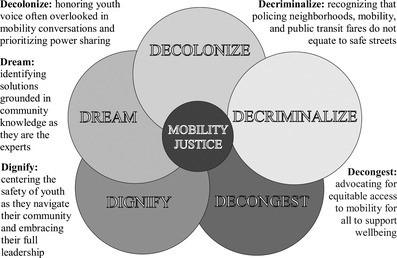Key takeaways:
- Using the mobility justice framework means recognizing the challenges and inequities that low-income youth of color face (particularly regarding active transportation) and integrating their knowledge into the transportation decision-making process.
- This study employed community-based participatory research, specifically photovoice, which uses photography and storytelling to set priorities and advocate for change. Through a series of sessions, the five domains known as the 5 D’s of the Mobility Justice
- The 5 D’s of Mobility Justice for Youth have been adapted from the mobility justice conceptual framework model from People for Mobility Justice.

- Providing free transit was one policy solution identified to reduce inequitable access to public transportation. This policy has received pushback due to unproven, non-materialized fears that such a policy would lead to an increase in problematic passengers, that would dissuade ridership.
- Youth in this study also recommended well-lit, connected sidewalks, leading to public transportation, green spaces, and community hubs, to increase perceptions of safety and comfort with neighborhood mobility.
Implications:
- Photovoice and storytelling are tools that practitioners can use to engage youth in low-income and communities of color. These methods are ways to employ a more inclusive collection of knowledge to inform transportation decision-making.
- There needs to be more work on developing trust between low-income neighborhoods and transportation planners. To this end, partnerships between community leaders, whom residents trust, and transportation planners are a meaningful first step.
Romano, E.F.T., Baquero, B., Hicks, O., Gardner, V.A., Shannon, K.L., Hoerster, K.D. “‘No one should feel like they’re unsafe.’ Mobility justice photovoice as a youth advocacy tool for equitable community mobility.” Family and Community Health 45, 4 (2022).
web resource

